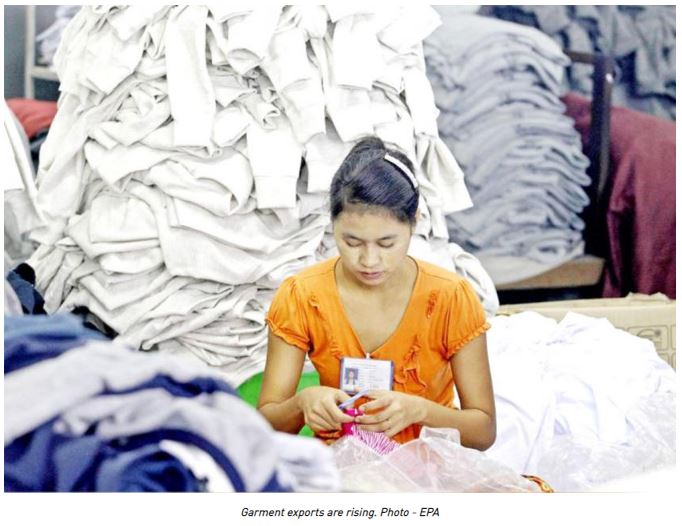Myanmar: Trade deficit narrows in Oct-Dec on higher exports
Myanmar reduced its trade deficit for the October-December 2018 quarter to US$833 million from $1.2 billion during the same period in 2017, according to government data. Total trade expanded to $8.1 billion during the quarter compared to $7.6 billion in 2017, with exports totaling $3.6 billion compared to imports of $4.5 billion.
Myanmar exports items from seven major commodity groups. These include manufactured goods consisting mainly of garments, as well as agriculture produce, minerals, cattle, fisheries and forestry products.
During the Oct-Dec 2018 quarter, exports rose by more than 26 percent compared to 2017, led mainly by garment exports to Europe, which offset a decline in the export of natural gas and minerals such as jade, according to the Ministry of Commerce.
In comparison, Myanmar’s major import items are divided into four groups — capital goods, intermediate goods, consumer goods and cut-make-pack (CMP) products. During the quarter, imports of CMP products surged, however, volumes fell across the other three groups, as a dearer exchange rate and higher oil prices bit into margins.
On one hand, the higher volume of exports reflects the government’s efforts to reduce the trade deficit by screening luxury imports, encouraging import substitutes and boosting exports. They also come at a time when foreign direct investments into the country have eased over the past year, according to official data.
Myanmar’s current account deficit, which includes the trade deficit, is financed mainly by foreign direct investments into the country.
On the other hand, the fall in imports of capital goods also reflects less demand and activity in the industrial and construction sectors, implying a slowdown in the broader economy, the World Bank said in its 2018 Myanmar report.
Barring a withdrawal of Europe’s Generalised System of Preferences, which allows Myanmar to enjoy zero import tariffs and quota-free access for its products, the World Bank is forecasting a further narrowing of the trade deficit this year, backed by higher exports and a slowdown in imports. Last year’s deficit of $300 million is already the lowest in five years, it said.
The trade deficit narrowed from 8.5pc of GDP in 2017 to 5.7 pc of GDP in 2018, driven by rapid increase in garment exports from 16.8pc of GDP to 20.2pc of GDP over the period, the World Bank said.
Imports increased marginally in the same period, with investment goods imports declining by 6pc in 20-18 due to declining industrial investment and moderation in construction activity.
Source: https://www.mmtimes.com/news/trade-deficit-narrows-oct-dec-higher-exports.html


 English
English




